steering MITSUBISHI COLT 2008 (in English) User Guide
[x] Cancel search | Manufacturer: MITSUBISHI, Model Year: 2008, Model line: COLT, Model: MITSUBISHI COLT 2008Pages: 450, PDF Size: 14.57 MB
Page 119 of 450
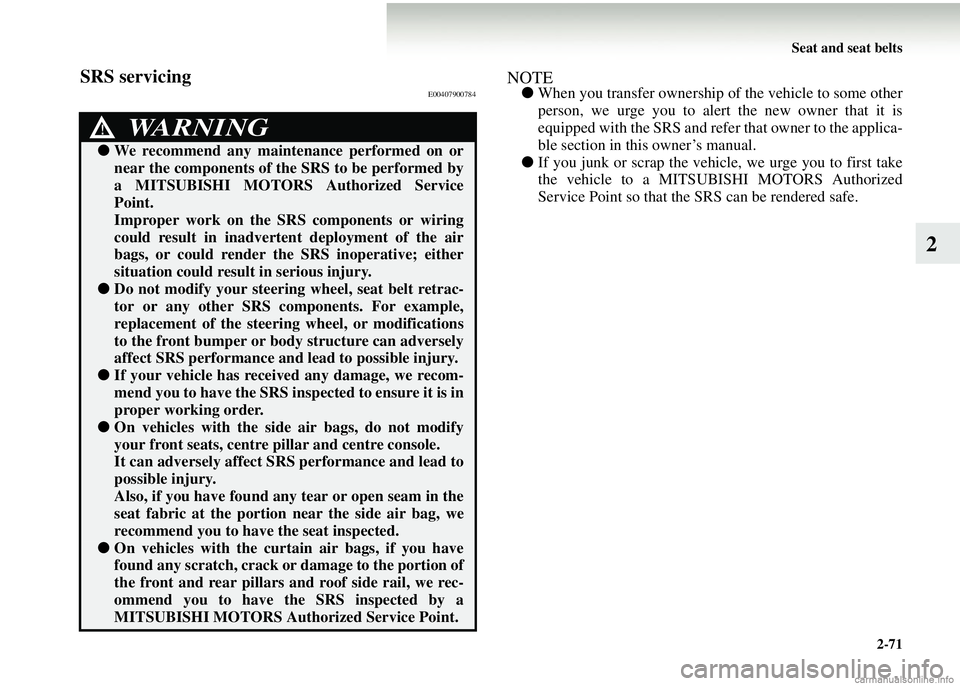
Seat and seat belts2-71
2
SRS servicingE00407900784NOTE●When you transfer ownership of the vehicle to some other
person, we urge you to alert the new owner that it is
equipped with the SRS and refer that owner to the applica-
ble section in this owner’s manual.
● If you junk or scrap the vehicle, we urge you to first take
the vehicle to a MITSUB ISHI MOTORS Authorized
Service Point so that the SRS can be rendered safe.
WARNING!
● We recommend any maintenance performed on or
near the components of the SRS to be performed by
a MITSUBISHI MOTORS Authorized Service
Point.
Improper work on the SRS components or wiring
could result in inadvert ent deployment of the air
bags, or could render the SRS inoperative; either
situation could result in serious injury.
● Do not modify your steering wheel, seat belt retrac-
tor or any other SRS components. For example,
replacement of the steering wheel, or modifications
to the front bumper or body structure can adversely
affect SRS performance and lead to possible injury.
● If your vehicle has receive d any damage, we recom-
mend you to have the SRS in spected to ensure it is in
proper working order.
● On vehicles with the side air bags, do not modify
your front seats, centre pillar and centre console.
It can adversely affect SRS performance and lead to
possible injury.
Also, if you have found any tear or open seam in the
seat fabric at the portion near the side air bag, we
recommend you to have the seat inspected.
●On vehicles with the curt ain air bags, if you have
found any scratch, crack or damage to the portion of
the front and rear pillars and roof side rail, we rec-
ommend you to have the SRS inspected by a
MITSUBISHI MOTORS Auth orized Service Point.
Page 127 of 450
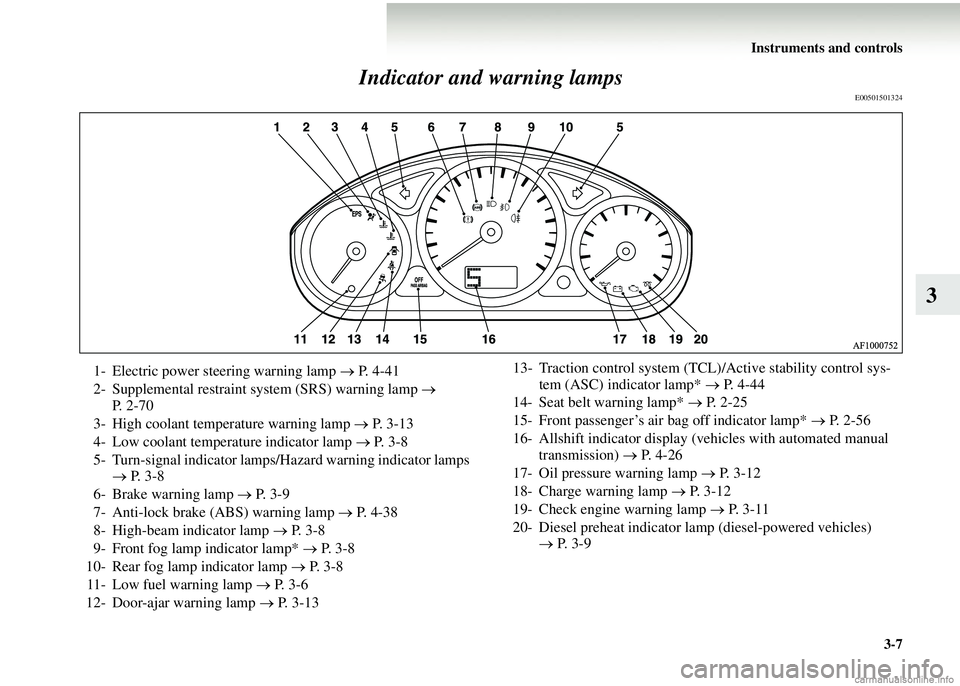
Instruments and controls3-7
3
Indicator and warning lamps
E00501501324
1- Electric power steering warning lamp
→ P. 4-41
2- Supplemental restraint system (SRS) warning lamp →
P. 2 - 7 0
3- High coolant temperature warning lamp → P. 3-13
4- Low coolant temperature indicator lamp → P. 3-8
5- Turn-signal indicator lamps/Hazard warning indicator lamps → P. 3-8
6- Brake warning lamp → P. 3-9
7- Anti-lock brake (ABS) warning lamp → P. 4-38
8- High-beam indicator lamp → P. 3-8
9- Front fog lamp indicator lamp* → P. 3-8
10- Rear fog lamp indicator lamp → P. 3-8
11- Low fuel warning lamp → P. 3-6
12- Door-ajar warning lamp → P. 3-13 13- Traction control system (TCL)/Active stability control sys-
tem (ASC) indicator lamp* → P. 4-44
14- Seat belt warning lamp* → P. 2 - 2 5
15- Front passenger’s air bag off indicator lamp* → P. 2-56
16- Allshift indicator display (vehicles with automated manual transmission) → P. 4-26
17- Oil pressure warning lamp → P. 3-12
18- Charge warning lamp → P. 3-12
19- Check engine warning lamp → P. 3 - 1 1
20- Diesel preheat indicator lamp (diesel-powered vehicles) → P. 3-9
Page 156 of 450
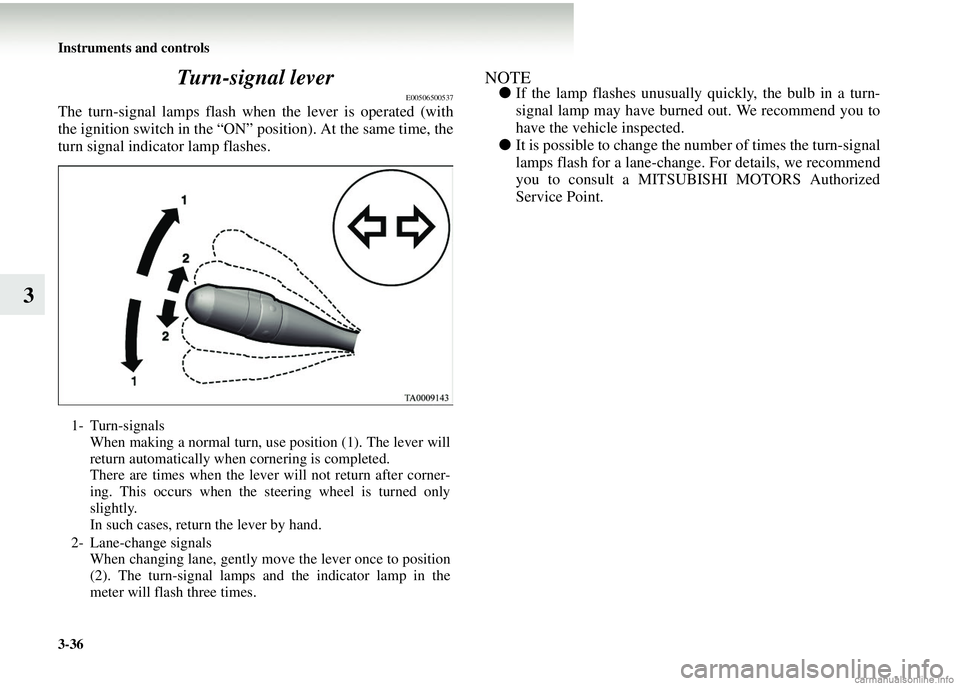
3-36 Instruments and controls
3Turn-signal lever
E00506500537
The turn-signal lamps flash when the lever is operated (with
the ignition switch in the “ON” position). At the same time, the
turn signal indicator lamp flashes.
NOTE●
If the lamp flashes unusually quickly, the bulb in a turn-
signal lamp may have burned out. We recommend you to
have the vehicle inspected.
● It is possible to change the number of times the turn-signal
lamps flash for a lane-change. For details, we recommend
you to consult a MITSUBISHI MOTORS Authorized
Service Point.
1- Turn-signals
When making a normal turn, use position (1). The lever will
return automatically when cornering is completed.
There are times when the lever will not return after corner-
ing. This occurs when the steering wheel is turned only
slightly.
In such cases, return the lever by hand.
2- Lane-change signals When changing lane, gently move the lever once to position
(2). The turn-signal lamps and the indicator lamp in the
meter will flash three times.
Page 166 of 450
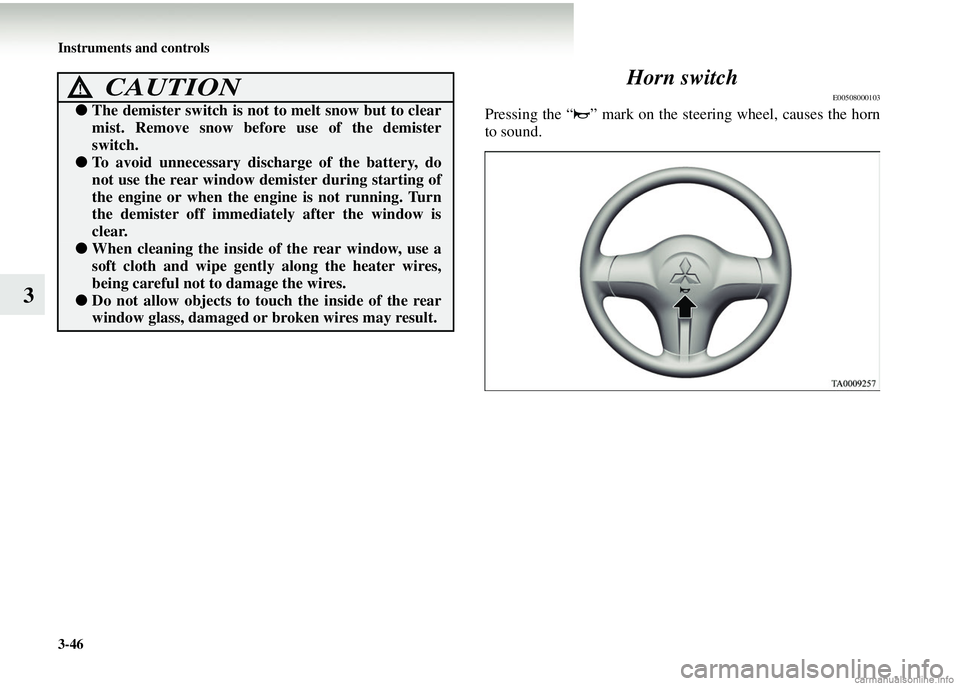
3-46 Instruments and controls
3Horn switch
E00508000103
Pressing the “ ” mark on the steering wheel, causes the horn
to sound.
CAUTION!
●
The demister switch is not to melt snow but to clear
mist. Remove snow before use of the demister
switch.
●To avoid unnecessary disc harge of the battery, do
not use the rear window de mister during starting of
the engine or when the en gine is not running. Turn
the demister off immediat ely after the window is
clear.
● When cleaning the inside of the rear window, use a
soft cloth and wipe gently along the heater wires,
being careful not to damage the wires.
●Do not allow objects to touch the inside of the rear
window glass, damaged or broken wires may result.
Page 167 of 450
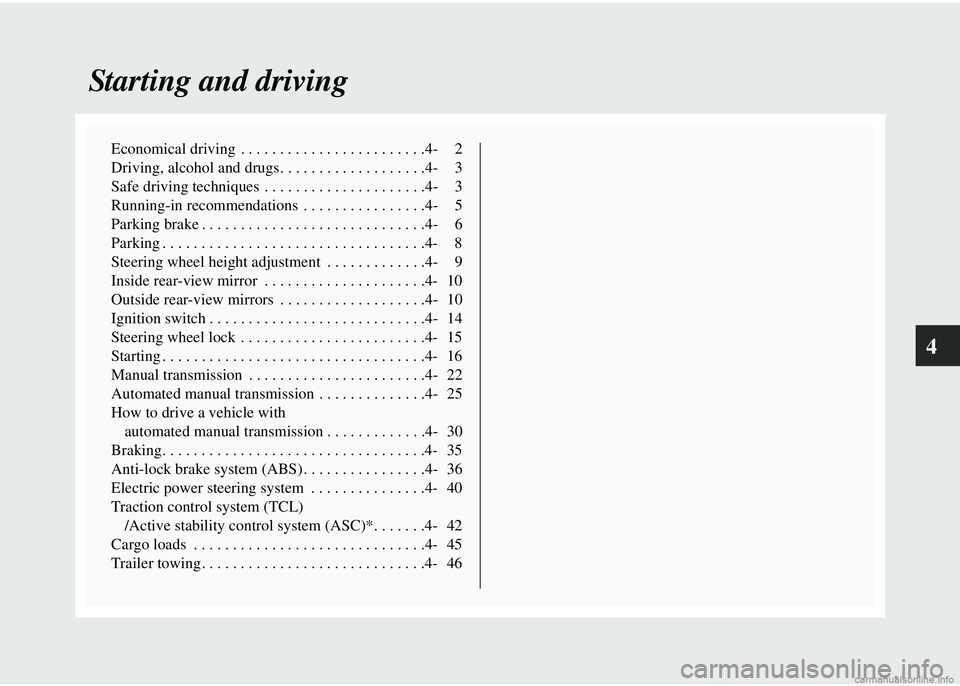
4
Starting and driving
Economical driving . . . . . . . . . . . . . . . . . . . . . . . .4- 2
Driving, alcohol and drugs. . . . . . . . . . . . . . . . . . .4- 3
Safe driving techniques . . . . . . . . . . . . . . . . . . . . .4- 3
Running-in recommendations . . . . . . . . . . . . . . . .4- 5
Parking brake . . . . . . . . . . . . . . . . . . . . . . . . . . . . .4- 6
Parking . . . . . . . . . . . . . . . . . . . . . . . . . . . . . . . . . .4- 8
Steering wheel height adjustment . . . . . . . . . . . . .4- 9
Inside rear-view mirror . . . . . . . . . . . . . . . . . . . . .4- 10
Outside rear-view mirrors . . . . . . . . . . . . . . . . . . .4- 10
Ignition switch . . . . . . . . . . . . . . . . . . . . . . . . . . . .4- 14
Steering wheel lock . . . . . . . . . . . . . . . . . . . . . . . .4- 15
Starting . . . . . . . . . . . . . . . . . . . . . . . . . . . . . . . . . .4- 16
Manual transmission . . . . . . . . . . . . . . . . . . . . . . .4- 22
Automated manual transmission . . . . . . . . . . . . . .4- 25
How to drive a vehicle with automated manual transmission . . . . . . . . . . . . .4- 30
Braking. . . . . . . . . . . . . . . . . . . . . . . . . . . . . . . . . .4- 35
Anti-lock brake system (ABS) . . . . . . . . . . . . . . . .4- 36
Electric power steering system . . . . . . . . . . . . . . .4- 40
Traction control system (TCL) /Active stability control syst em (ASC)*. . . . . . .4- 42
Cargo loads . . . . . . . . . . . . . . . . . . . . . . . . . . . . . .4- 45
Trailer towing. . . . . . . . . . . . . . . . . . . . . . . . . . . . .4- 46
Page 175 of 450
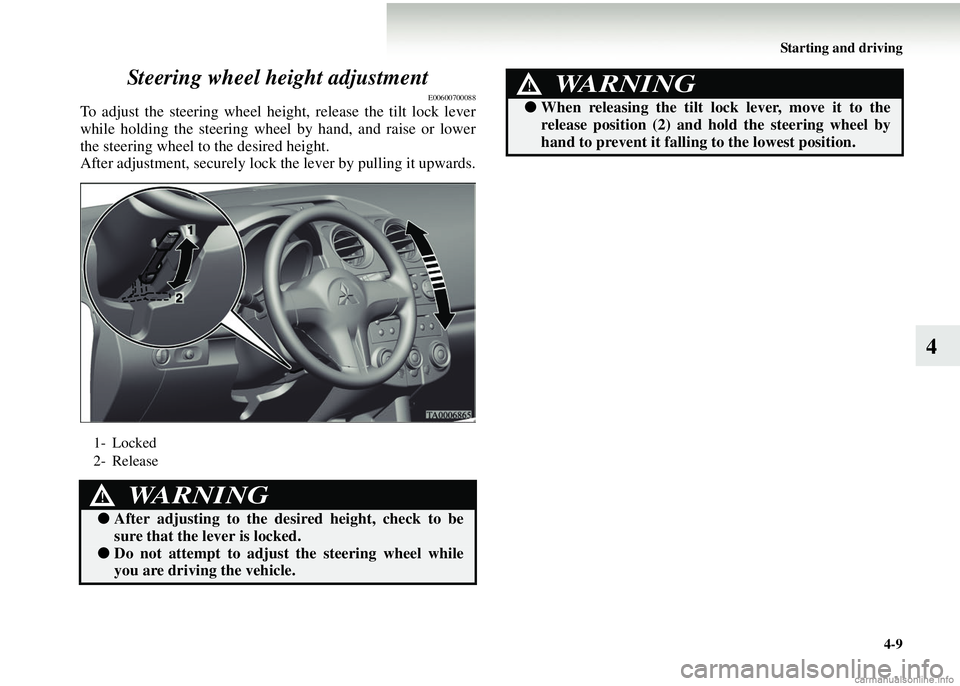
Starting and driving4-9
4
Steering wheel height adjustment
E00600700088
To adjust the steering wheel height, release the tilt lock lever
while holding the steering wheel by hand, and raise or lower
the steering wheel to the desired height.
After adjustment, securely lock the lever by pulling it upwards.
1- Locked
2- Release
WARNING!
●
After adjusting to the desired height, check to be
sure that the lever is locked.
●Do not attempt to adjust the steering wheel while
you are drivin g the vehicle.
●When releasing the tilt lock lever, move it to the
release position (2) and hold the steering wheel by
hand to prevent it falling to the lowest position.
WARNING!
Page 180 of 450
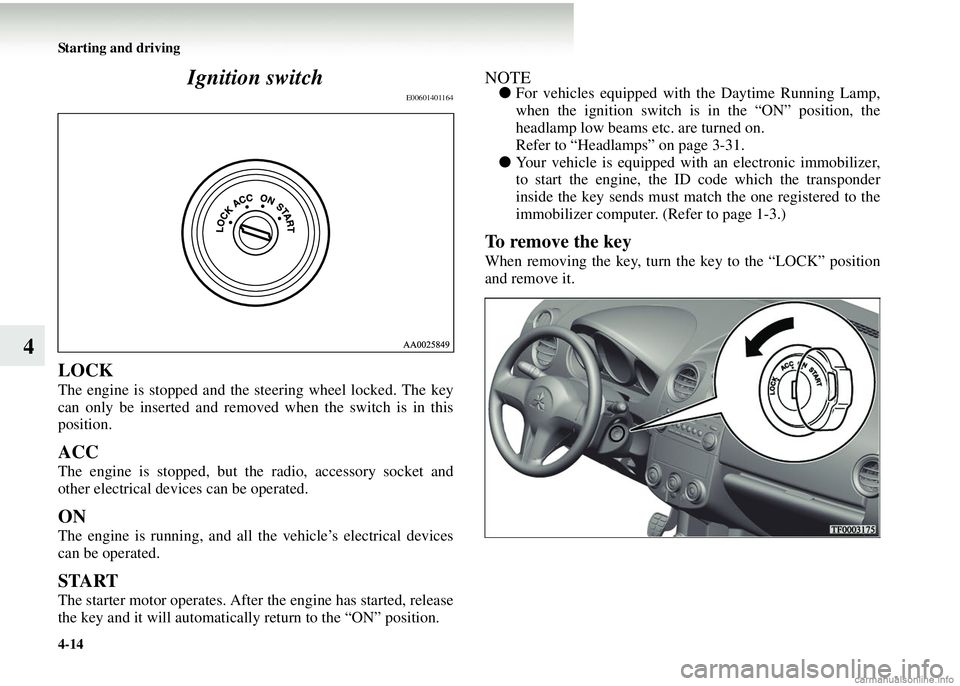
4-14 Starting and driving
4Ignition switch
E00601401164
LOCK
The engine is stopped and the
steering wheel locked. The key
can only be inserted and removed when the switch is in this
position.
ACC
The engine is stopped, but th e radio, accessory socket and
other electrical devices can be operated.
ON
The engine is running, and all the vehicle’s electrical devices
can be operated.
START
The starter motor operates. After the engine has started, release
the key and it will automatically return to the “ON” position.
NOTE● For vehicles equipped with the Daytime Running Lamp,
when the ignition switch is in the “ON” position, the
headlamp low beams etc. are turned on.
Refer to “Headlamps” on page 3-31.
● Your vehicle is equipped with an electronic immobilizer,
to start the engine, the ID code which the transponder
inside the key sends must match the one registered to the
immobilizer computer. (Refer to page 1-3.)
To remove the key
When removing the key, turn the key to the “LOCK” position
and remove it.
Page 181 of 450
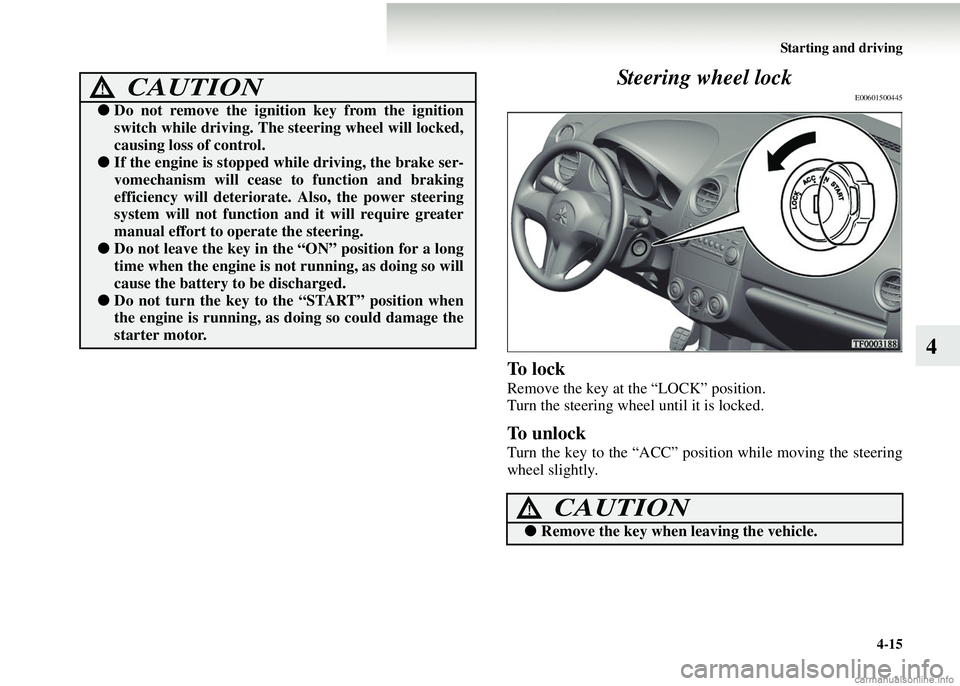
Starting and driving4-15
4
Steering wheel lock
E00601500445
To l o c k
Remove the key at the “LOCK” position.
Turn the steering wheel until it is locked.
To unlock
Turn the key to the “ACC” position while moving the steering
wheel slightly.
CAUTION!
●
Do not remove the ignition key from the ignition
switch while driving. The steering wheel will locked,
causing loss of control.
●If the engine is stopped while driving, the brake ser-
vomechanism will cease to function and braking
efficiency will deteriorat e. Also, the power steering
system will not function and it will require greater
manual effort to operate the steering.
● Do not leave the key in the “ON” position for a long
time when the engine is no t running, as doing so will
cause the battery to be discharged.
●Do not turn the key to the “START” position when
the engine is running, as doing so could damage the
starter motor.
CAUTION!
●Remove the key when leaving the vehicle.
Page 202 of 450
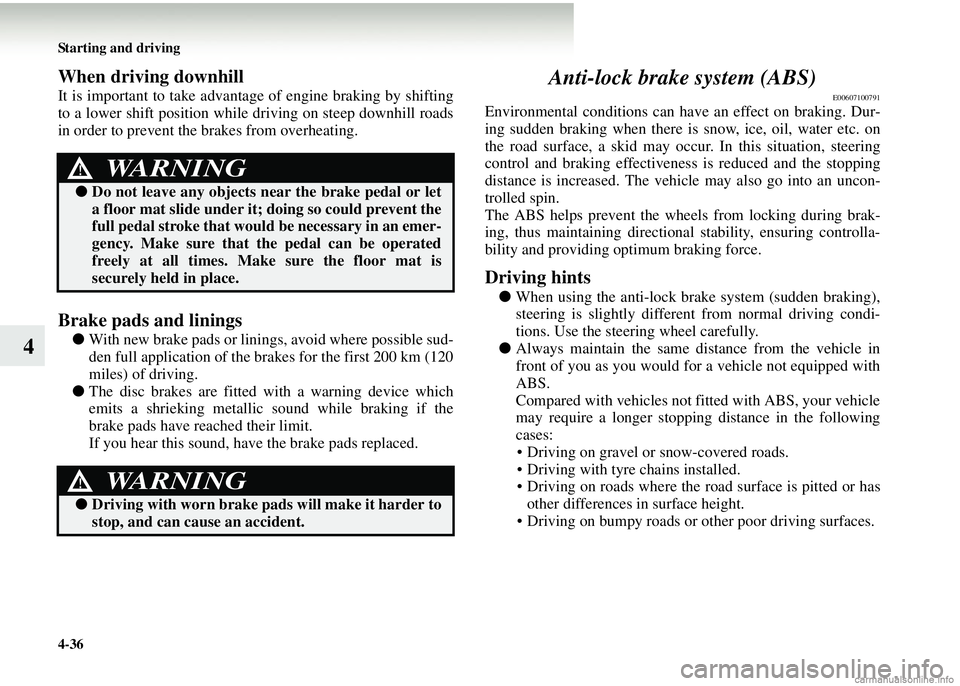
4-36 Starting and driving
4
When driving downhill
It is important to take advantage of engine braking by shifting
to a lower shift position while driving on steep downhill roads
in order to prevent the brakes from overheating.
Brake pads and linings
●With new brake pads or linings, avoid where possible sud-
den full application of the brakes for the first 200 km (120
miles) of driving.
● The disc brakes are fitted with a warning device which
emits a shrieking metallic sound while braking if the
brake pads have reached their limit.
If you hear this sound, have the brake pads replaced.
Anti-lock brake system (ABS)
E00607100791
Environmental conditions can ha ve an effect on braking. Dur-
ing sudden braking when there is snow, ice, oil, water etc. on
the road surface, a skid may occur. In this situation, steering
control and braking effectivenes s is reduced and the stopping
distance is increased. The vehicl e may also go into an uncon-
trolled spin.
The ABS helps prevent the wheel s from locking during brak-
ing, thus maintaining directional stability, ensuring controlla-
bility and providing optimum braking force.
Driving hints
● When using the anti-lock brak e system (sudden braking),
steering is slightly different from normal driving condi-
tions. Use the steering wheel carefully.
● Always maintain the same di stance from the vehicle in
front of you as you would for a vehicle not equipped with
ABS.
Compared with vehicles not fitted with ABS, your vehicle
may require a longer stopping distance in the following
cases:
• Driving on gravel or snow-covered roads.
• Driving with tyre chains installed.
• Driving on roads where the road surface is pitted or has
other differences in surface height.
• Driving on bumpy roads or other poor driving surfaces.
WARNING!
●Do not leave any objects ne ar the brake pedal or let
a floor mat slide under it; doing so could prevent the
full pedal stroke that woul d be necessary in an emer-
gency. Make sure that the pedal can be operated
freely at all times. Make sure the floor mat is
securely held in place.
WARNING!
● Driving with worn brake pads will make it harder to
stop, and can cause an accident.
Page 206 of 450
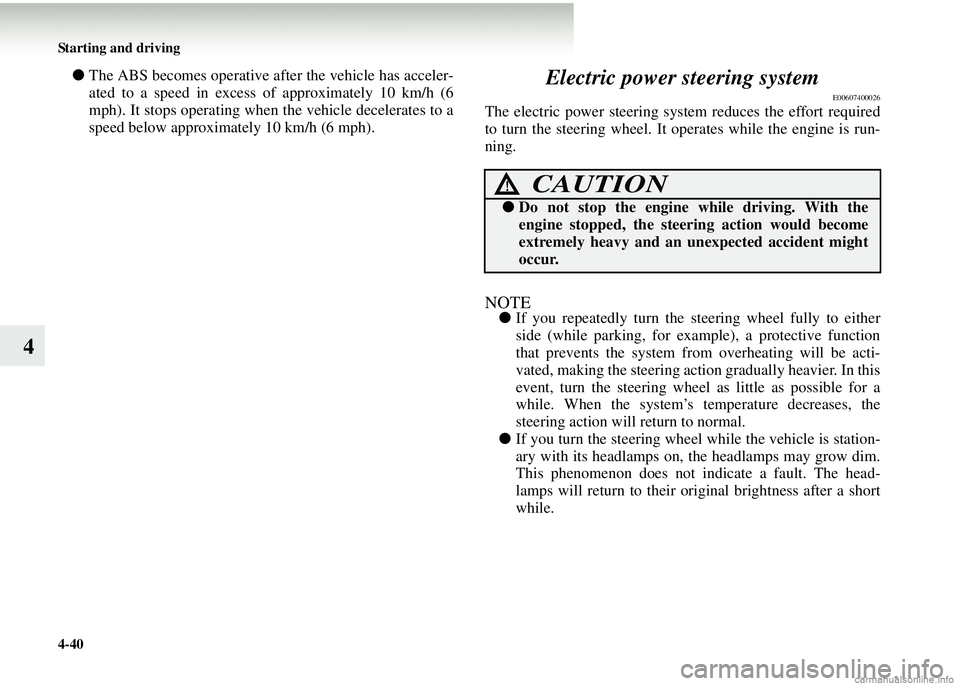
4-40 Starting and driving
4
●The ABS becomes operative after the vehicle has acceler-
ated to a speed in excess of approximately 10 km/h (6
mph). It stops operat ing when the vehicle decelerates to a
speed below approximately 10 km/h (6 mph).Electric power steering system
E00607400026
The electric power steering system reduces the effort required
to turn the steering wheel. It operates while the engine is run-
ning.
NOTE● If you repeatedly turn the st eering wheel fully to either
side (while parking, for example), a protective function
that prevents the system from overheating will be acti-
vated, making the steering action gradually heavier. In this
event, turn the steering wheel as little as possible for a
while. When the system’s temperature decreases, the
steering action will return to normal.
● If you turn the steering wheel while the vehicle is station-
ary with its headlamps on, the headlamps may grow dim.
This phenomenon does not indicate a fault. The head-
lamps will return to their original brightness after a short
while.
CAUTION!
●Do not stop the engine while driving. With the
engine stopped, the steeri ng action would become
extremely heavy and an une xpected accident might
occur.